Impact of Social Stigma on Depression Treatment Seeking Behaviors
VerifiedAdded on 2020/02/17
|27
|8430
|106
Report
AI Summary
This research project investigates the impact of social stigma on attitudes toward seeking treatment for depression. The report begins with an introduction, outlining the research aims, objectives, and rationale, followed by a comprehensive literature review that explores the impact of depression on behavior, problems faced during treatment, and effective strategies to address social stigma. The methodology section details the research design, approach, philosophy, data collection techniques, sampling, and ethical considerations. The data analysis chapter presents the findings, followed by a conclusion and recommendations, including areas for further study. The study aims to evaluate the effects of depression on behavior, identify treatment-related problems, and determine effective ways to combat social stigma, providing recommendations for the NHS to enhance services and achieve competitive advantages. The research highlights the importance of understanding the social context of mental illness and its influence on treatment-seeking behaviors.
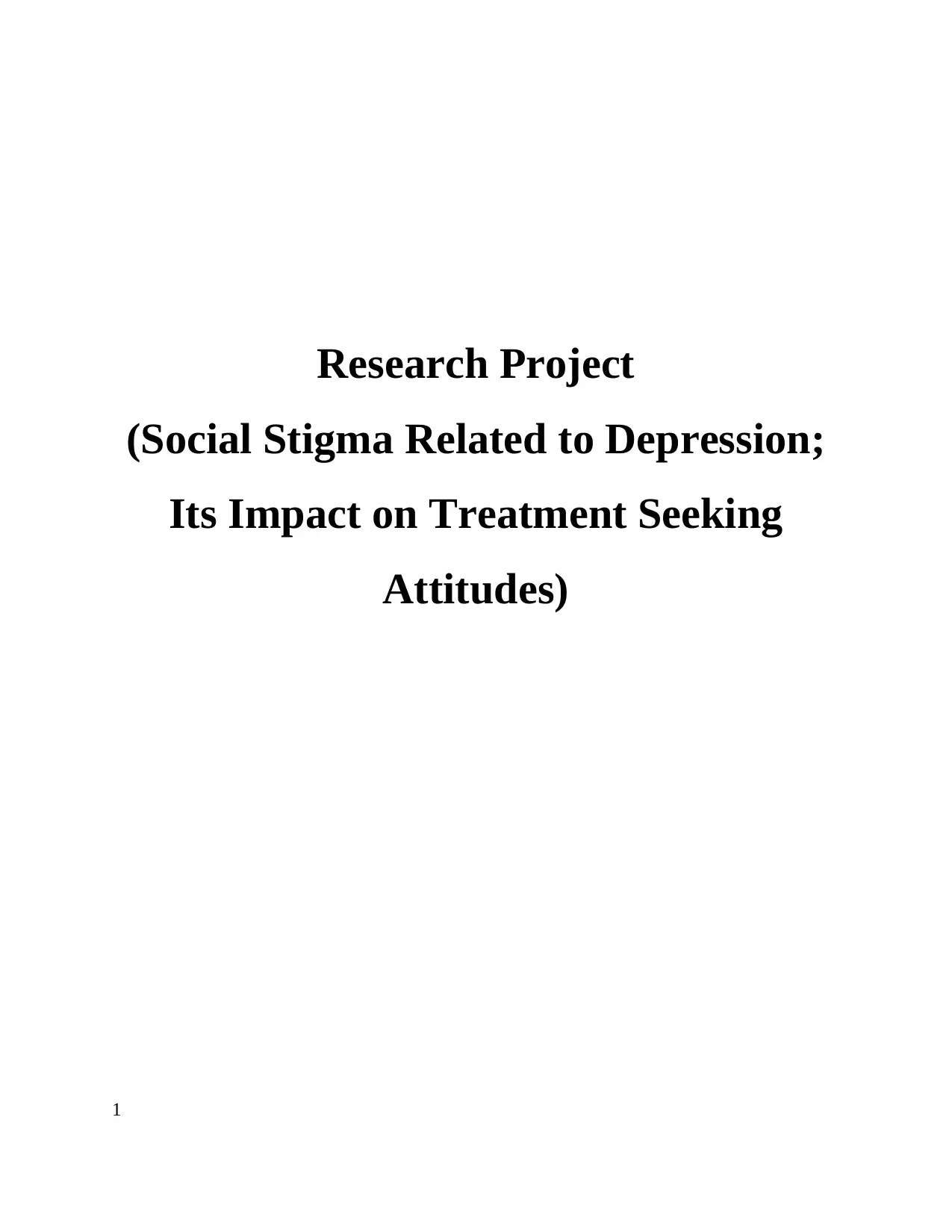
Research Project
(Social Stigma Related to Depression;
Its Impact on Treatment Seeking
Attitudes)
1
(Social Stigma Related to Depression;
Its Impact on Treatment Seeking
Attitudes)
1
Paraphrase This Document
Need a fresh take? Get an instant paraphrase of this document with our AI Paraphraser
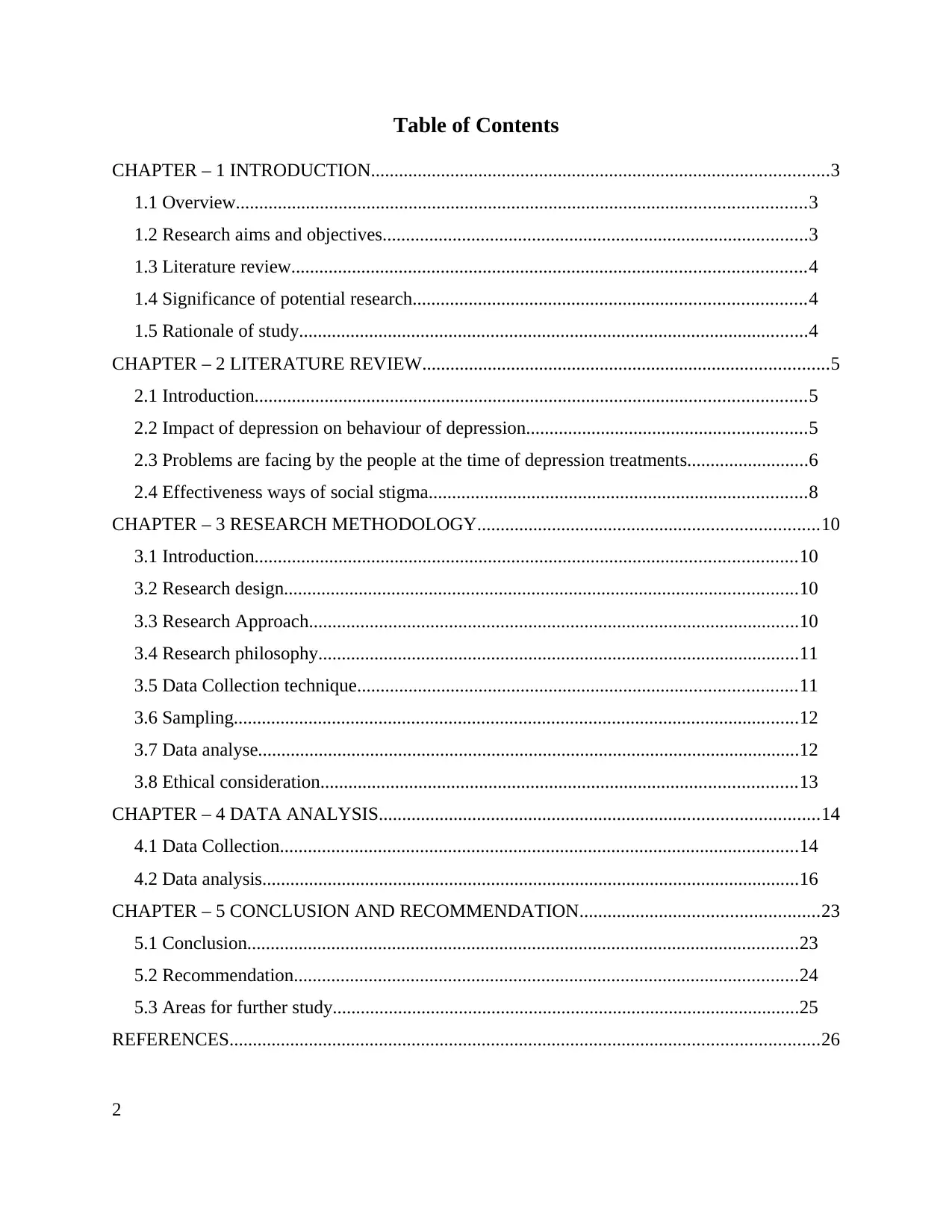
Table of Contents
CHAPTER – 1 INTRODUCTION..................................................................................................3
1.1 Overview..........................................................................................................................3
1.2 Research aims and objectives...........................................................................................3
1.3 Literature review..............................................................................................................4
1.4 Significance of potential research....................................................................................4
1.5 Rationale of study.............................................................................................................4
CHAPTER – 2 LITERATURE REVIEW.......................................................................................5
2.1 Introduction......................................................................................................................5
2.2 Impact of depression on behaviour of depression............................................................5
2.3 Problems are facing by the people at the time of depression treatments..........................6
2.4 Effectiveness ways of social stigma.................................................................................8
CHAPTER – 3 RESEARCH METHODOLOGY.........................................................................10
3.1 Introduction....................................................................................................................10
3.2 Research design..............................................................................................................10
3.3 Research Approach.........................................................................................................10
3.4 Research philosophy.......................................................................................................11
3.5 Data Collection technique..............................................................................................11
3.6 Sampling.........................................................................................................................12
3.7 Data analyse....................................................................................................................12
3.8 Ethical consideration......................................................................................................13
CHAPTER – 4 DATA ANALYSIS..............................................................................................14
4.1 Data Collection...............................................................................................................14
4.2 Data analysis...................................................................................................................16
CHAPTER – 5 CONCLUSION AND RECOMMENDATION...................................................23
5.1 Conclusion......................................................................................................................23
5.2 Recommendation............................................................................................................24
5.3 Areas for further study....................................................................................................25
REFERENCES..............................................................................................................................26
2
CHAPTER – 1 INTRODUCTION..................................................................................................3
1.1 Overview..........................................................................................................................3
1.2 Research aims and objectives...........................................................................................3
1.3 Literature review..............................................................................................................4
1.4 Significance of potential research....................................................................................4
1.5 Rationale of study.............................................................................................................4
CHAPTER – 2 LITERATURE REVIEW.......................................................................................5
2.1 Introduction......................................................................................................................5
2.2 Impact of depression on behaviour of depression............................................................5
2.3 Problems are facing by the people at the time of depression treatments..........................6
2.4 Effectiveness ways of social stigma.................................................................................8
CHAPTER – 3 RESEARCH METHODOLOGY.........................................................................10
3.1 Introduction....................................................................................................................10
3.2 Research design..............................................................................................................10
3.3 Research Approach.........................................................................................................10
3.4 Research philosophy.......................................................................................................11
3.5 Data Collection technique..............................................................................................11
3.6 Sampling.........................................................................................................................12
3.7 Data analyse....................................................................................................................12
3.8 Ethical consideration......................................................................................................13
CHAPTER – 4 DATA ANALYSIS..............................................................................................14
4.1 Data Collection...............................................................................................................14
4.2 Data analysis...................................................................................................................16
CHAPTER – 5 CONCLUSION AND RECOMMENDATION...................................................23
5.1 Conclusion......................................................................................................................23
5.2 Recommendation............................................................................................................24
5.3 Areas for further study....................................................................................................25
REFERENCES..............................................................................................................................26
2
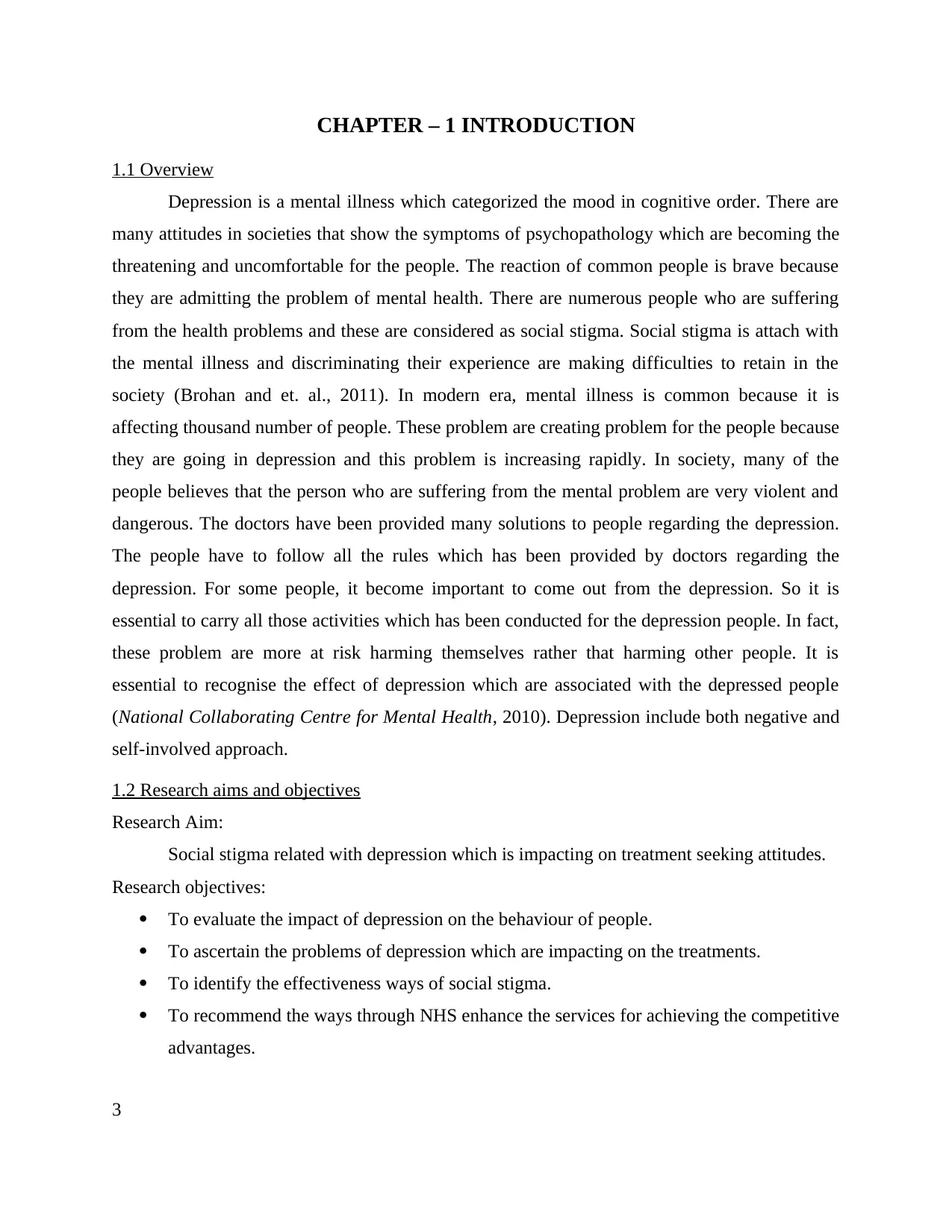
CHAPTER – 1 INTRODUCTION
1.1 Overview
Depression is a mental illness which categorized the mood in cognitive order. There are
many attitudes in societies that show the symptoms of psychopathology which are becoming the
threatening and uncomfortable for the people. The reaction of common people is brave because
they are admitting the problem of mental health. There are numerous people who are suffering
from the health problems and these are considered as social stigma. Social stigma is attach with
the mental illness and discriminating their experience are making difficulties to retain in the
society (Brohan and et. al., 2011). In modern era, mental illness is common because it is
affecting thousand number of people. These problem are creating problem for the people because
they are going in depression and this problem is increasing rapidly. In society, many of the
people believes that the person who are suffering from the mental problem are very violent and
dangerous. The doctors have been provided many solutions to people regarding the depression.
The people have to follow all the rules which has been provided by doctors regarding the
depression. For some people, it become important to come out from the depression. So it is
essential to carry all those activities which has been conducted for the depression people. In fact,
these problem are more at risk harming themselves rather that harming other people. It is
essential to recognise the effect of depression which are associated with the depressed people
(National Collaborating Centre for Mental Health, 2010). Depression include both negative and
self-involved approach.
1.2 Research aims and objectives
Research Aim:
Social stigma related with depression which is impacting on treatment seeking attitudes.
Research objectives:
To evaluate the impact of depression on the behaviour of people.
To ascertain the problems of depression which are impacting on the treatments.
To identify the effectiveness ways of social stigma.
To recommend the ways through NHS enhance the services for achieving the competitive
advantages.
3
1.1 Overview
Depression is a mental illness which categorized the mood in cognitive order. There are
many attitudes in societies that show the symptoms of psychopathology which are becoming the
threatening and uncomfortable for the people. The reaction of common people is brave because
they are admitting the problem of mental health. There are numerous people who are suffering
from the health problems and these are considered as social stigma. Social stigma is attach with
the mental illness and discriminating their experience are making difficulties to retain in the
society (Brohan and et. al., 2011). In modern era, mental illness is common because it is
affecting thousand number of people. These problem are creating problem for the people because
they are going in depression and this problem is increasing rapidly. In society, many of the
people believes that the person who are suffering from the mental problem are very violent and
dangerous. The doctors have been provided many solutions to people regarding the depression.
The people have to follow all the rules which has been provided by doctors regarding the
depression. For some people, it become important to come out from the depression. So it is
essential to carry all those activities which has been conducted for the depression people. In fact,
these problem are more at risk harming themselves rather that harming other people. It is
essential to recognise the effect of depression which are associated with the depressed people
(National Collaborating Centre for Mental Health, 2010). Depression include both negative and
self-involved approach.
1.2 Research aims and objectives
Research Aim:
Social stigma related with depression which is impacting on treatment seeking attitudes.
Research objectives:
To evaluate the impact of depression on the behaviour of people.
To ascertain the problems of depression which are impacting on the treatments.
To identify the effectiveness ways of social stigma.
To recommend the ways through NHS enhance the services for achieving the competitive
advantages.
3
⊘ This is a preview!⊘
Do you want full access?
Subscribe today to unlock all pages.

Trusted by 1+ million students worldwide
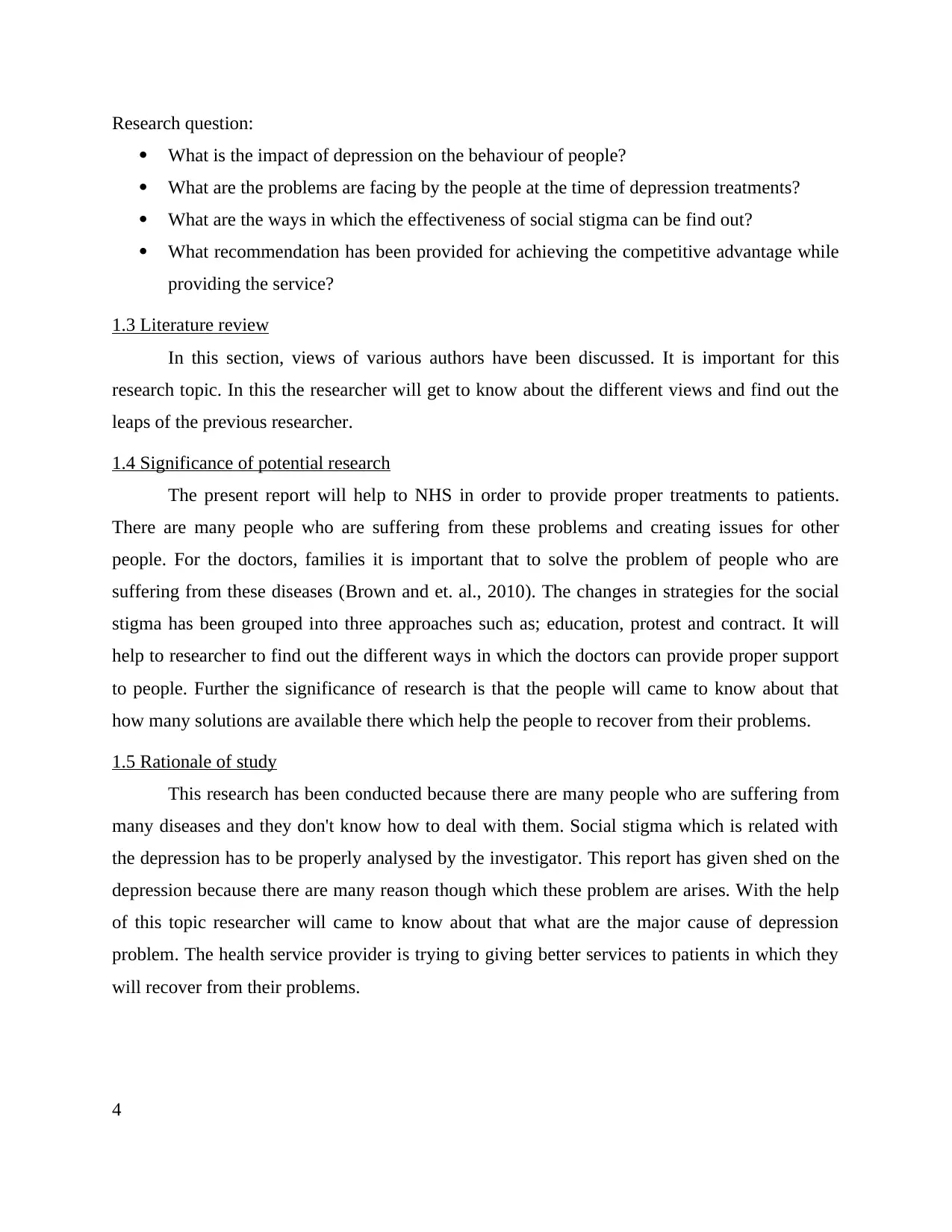
Research question:
What is the impact of depression on the behaviour of people?
What are the problems are facing by the people at the time of depression treatments?
What are the ways in which the effectiveness of social stigma can be find out?
What recommendation has been provided for achieving the competitive advantage while
providing the service?
1.3 Literature review
In this section, views of various authors have been discussed. It is important for this
research topic. In this the researcher will get to know about the different views and find out the
leaps of the previous researcher.
1.4 Significance of potential research
The present report will help to NHS in order to provide proper treatments to patients.
There are many people who are suffering from these problems and creating issues for other
people. For the doctors, families it is important that to solve the problem of people who are
suffering from these diseases (Brown and et. al., 2010). The changes in strategies for the social
stigma has been grouped into three approaches such as; education, protest and contract. It will
help to researcher to find out the different ways in which the doctors can provide proper support
to people. Further the significance of research is that the people will came to know about that
how many solutions are available there which help the people to recover from their problems.
1.5 Rationale of study
This research has been conducted because there are many people who are suffering from
many diseases and they don't know how to deal with them. Social stigma which is related with
the depression has to be properly analysed by the investigator. This report has given shed on the
depression because there are many reason though which these problem are arises. With the help
of this topic researcher will came to know about that what are the major cause of depression
problem. The health service provider is trying to giving better services to patients in which they
will recover from their problems.
4
What is the impact of depression on the behaviour of people?
What are the problems are facing by the people at the time of depression treatments?
What are the ways in which the effectiveness of social stigma can be find out?
What recommendation has been provided for achieving the competitive advantage while
providing the service?
1.3 Literature review
In this section, views of various authors have been discussed. It is important for this
research topic. In this the researcher will get to know about the different views and find out the
leaps of the previous researcher.
1.4 Significance of potential research
The present report will help to NHS in order to provide proper treatments to patients.
There are many people who are suffering from these problems and creating issues for other
people. For the doctors, families it is important that to solve the problem of people who are
suffering from these diseases (Brown and et. al., 2010). The changes in strategies for the social
stigma has been grouped into three approaches such as; education, protest and contract. It will
help to researcher to find out the different ways in which the doctors can provide proper support
to people. Further the significance of research is that the people will came to know about that
how many solutions are available there which help the people to recover from their problems.
1.5 Rationale of study
This research has been conducted because there are many people who are suffering from
many diseases and they don't know how to deal with them. Social stigma which is related with
the depression has to be properly analysed by the investigator. This report has given shed on the
depression because there are many reason though which these problem are arises. With the help
of this topic researcher will came to know about that what are the major cause of depression
problem. The health service provider is trying to giving better services to patients in which they
will recover from their problems.
4
Paraphrase This Document
Need a fresh take? Get an instant paraphrase of this document with our AI Paraphraser
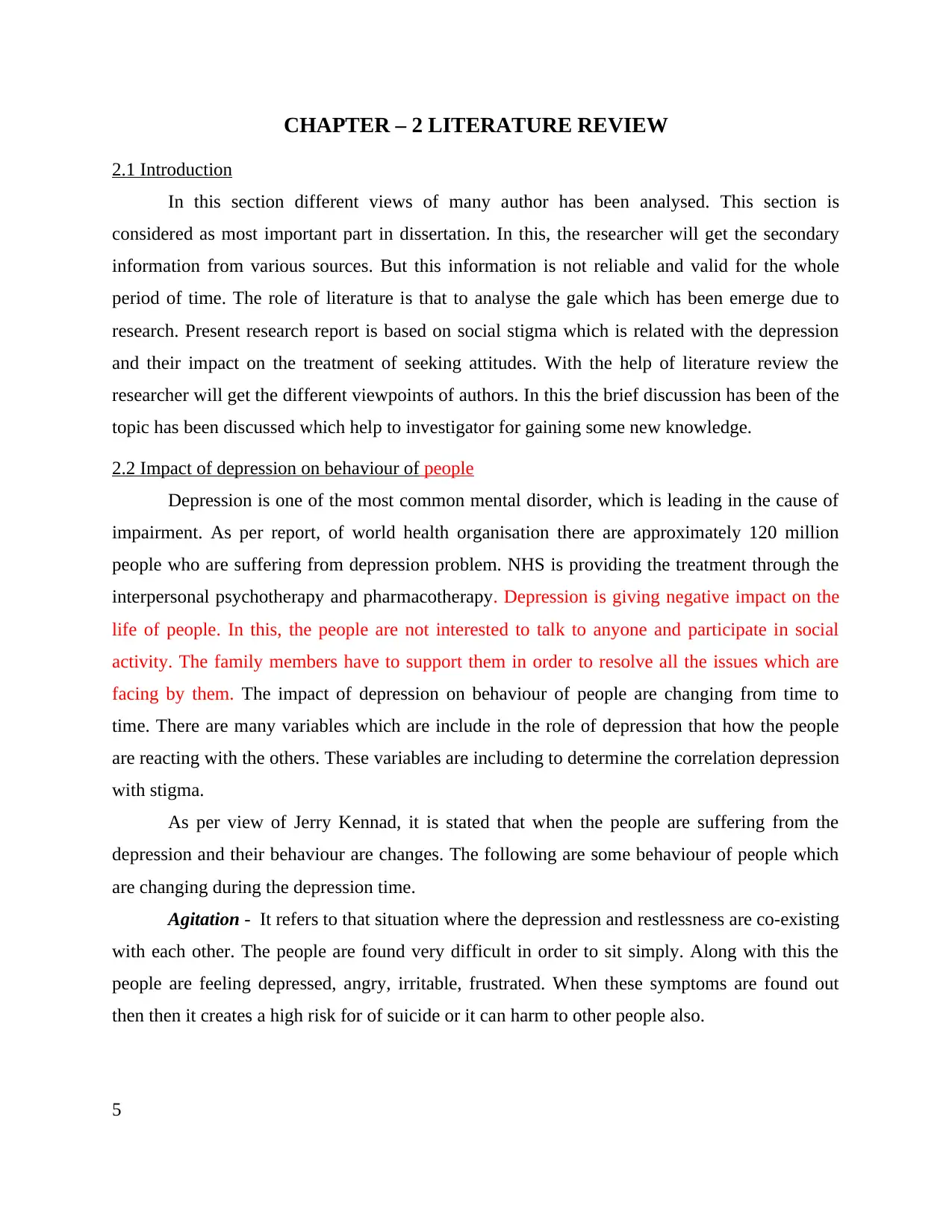
CHAPTER – 2 LITERATURE REVIEW
2.1 Introduction
In this section different views of many author has been analysed. This section is
considered as most important part in dissertation. In this, the researcher will get the secondary
information from various sources. But this information is not reliable and valid for the whole
period of time. The role of literature is that to analyse the gale which has been emerge due to
research. Present research report is based on social stigma which is related with the depression
and their impact on the treatment of seeking attitudes. With the help of literature review the
researcher will get the different viewpoints of authors. In this the brief discussion has been of the
topic has been discussed which help to investigator for gaining some new knowledge.
2.2 Impact of depression on behaviour of people
Depression is one of the most common mental disorder, which is leading in the cause of
impairment. As per report, of world health organisation there are approximately 120 million
people who are suffering from depression problem. NHS is providing the treatment through the
interpersonal psychotherapy and pharmacotherapy. Depression is giving negative impact on the
life of people. In this, the people are not interested to talk to anyone and participate in social
activity. The family members have to support them in order to resolve all the issues which are
facing by them. The impact of depression on behaviour of people are changing from time to
time. There are many variables which are include in the role of depression that how the people
are reacting with the others. These variables are including to determine the correlation depression
with stigma.
As per view of Jerry Kennad, it is stated that when the people are suffering from the
depression and their behaviour are changes. The following are some behaviour of people which
are changing during the depression time.
Agitation - It refers to that situation where the depression and restlessness are co-existing
with each other. The people are found very difficult in order to sit simply. Along with this the
people are feeling depressed, angry, irritable, frustrated. When these symptoms are found out
then then it creates a high risk for of suicide or it can harm to other people also.
5
2.1 Introduction
In this section different views of many author has been analysed. This section is
considered as most important part in dissertation. In this, the researcher will get the secondary
information from various sources. But this information is not reliable and valid for the whole
period of time. The role of literature is that to analyse the gale which has been emerge due to
research. Present research report is based on social stigma which is related with the depression
and their impact on the treatment of seeking attitudes. With the help of literature review the
researcher will get the different viewpoints of authors. In this the brief discussion has been of the
topic has been discussed which help to investigator for gaining some new knowledge.
2.2 Impact of depression on behaviour of people
Depression is one of the most common mental disorder, which is leading in the cause of
impairment. As per report, of world health organisation there are approximately 120 million
people who are suffering from depression problem. NHS is providing the treatment through the
interpersonal psychotherapy and pharmacotherapy. Depression is giving negative impact on the
life of people. In this, the people are not interested to talk to anyone and participate in social
activity. The family members have to support them in order to resolve all the issues which are
facing by them. The impact of depression on behaviour of people are changing from time to
time. There are many variables which are include in the role of depression that how the people
are reacting with the others. These variables are including to determine the correlation depression
with stigma.
As per view of Jerry Kennad, it is stated that when the people are suffering from the
depression and their behaviour are changes. The following are some behaviour of people which
are changing during the depression time.
Agitation - It refers to that situation where the depression and restlessness are co-existing
with each other. The people are found very difficult in order to sit simply. Along with this the
people are feeling depressed, angry, irritable, frustrated. When these symptoms are found out
then then it creates a high risk for of suicide or it can harm to other people also.
5
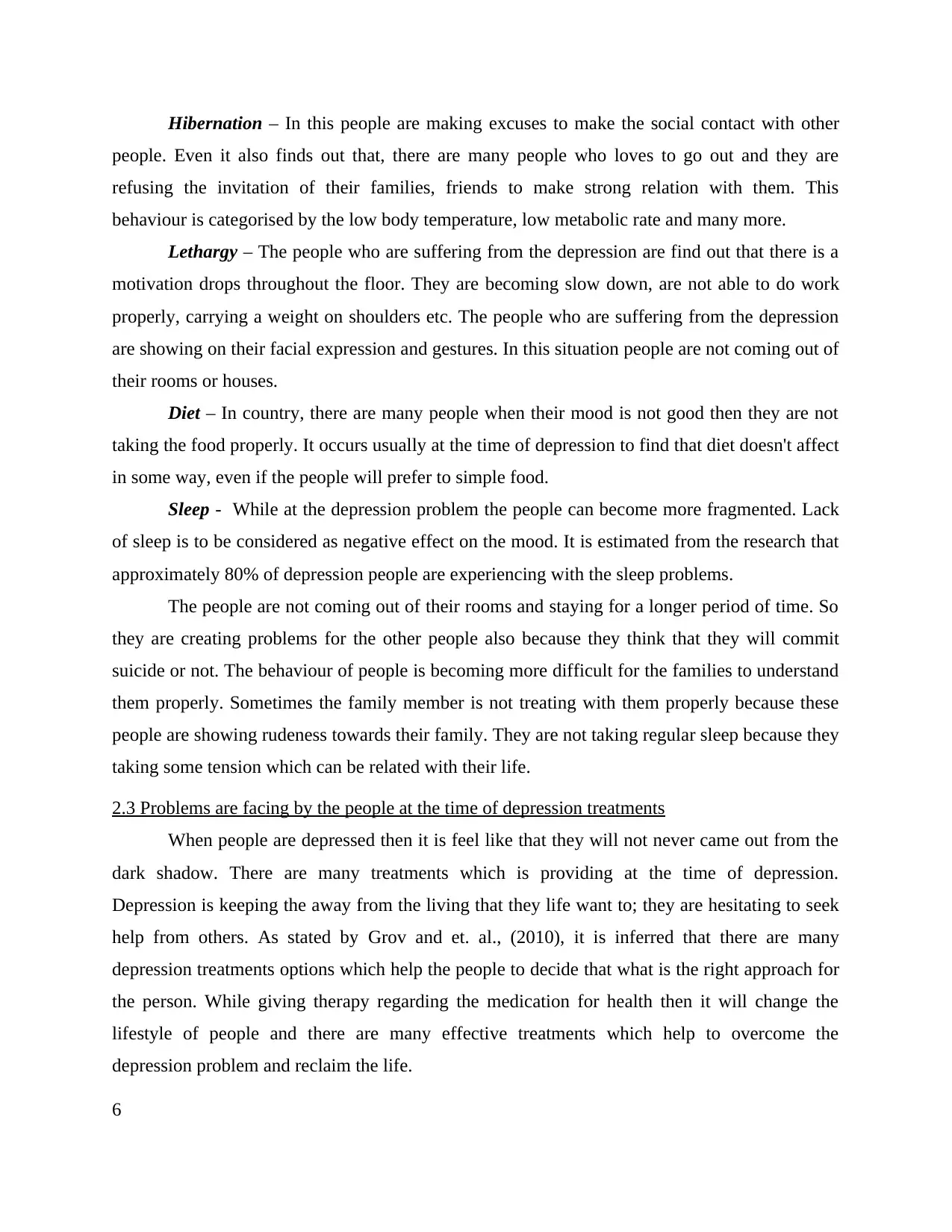
Hibernation – In this people are making excuses to make the social contact with other
people. Even it also finds out that, there are many people who loves to go out and they are
refusing the invitation of their families, friends to make strong relation with them. This
behaviour is categorised by the low body temperature, low metabolic rate and many more.
Lethargy – The people who are suffering from the depression are find out that there is a
motivation drops throughout the floor. They are becoming slow down, are not able to do work
properly, carrying a weight on shoulders etc. The people who are suffering from the depression
are showing on their facial expression and gestures. In this situation people are not coming out of
their rooms or houses.
Diet – In country, there are many people when their mood is not good then they are not
taking the food properly. It occurs usually at the time of depression to find that diet doesn't affect
in some way, even if the people will prefer to simple food.
Sleep - While at the depression problem the people can become more fragmented. Lack
of sleep is to be considered as negative effect on the mood. It is estimated from the research that
approximately 80% of depression people are experiencing with the sleep problems.
The people are not coming out of their rooms and staying for a longer period of time. So
they are creating problems for the other people also because they think that they will commit
suicide or not. The behaviour of people is becoming more difficult for the families to understand
them properly. Sometimes the family member is not treating with them properly because these
people are showing rudeness towards their family. They are not taking regular sleep because they
taking some tension which can be related with their life.
2.3 Problems are facing by the people at the time of depression treatments
When people are depressed then it is feel like that they will not never came out from the
dark shadow. There are many treatments which is providing at the time of depression.
Depression is keeping the away from the living that they life want to; they are hesitating to seek
help from others. As stated by Grov and et. al., (2010), it is inferred that there are many
depression treatments options which help the people to decide that what is the right approach for
the person. While giving therapy regarding the medication for health then it will change the
lifestyle of people and there are many effective treatments which help to overcome the
depression problem and reclaim the life.
6
people. Even it also finds out that, there are many people who loves to go out and they are
refusing the invitation of their families, friends to make strong relation with them. This
behaviour is categorised by the low body temperature, low metabolic rate and many more.
Lethargy – The people who are suffering from the depression are find out that there is a
motivation drops throughout the floor. They are becoming slow down, are not able to do work
properly, carrying a weight on shoulders etc. The people who are suffering from the depression
are showing on their facial expression and gestures. In this situation people are not coming out of
their rooms or houses.
Diet – In country, there are many people when their mood is not good then they are not
taking the food properly. It occurs usually at the time of depression to find that diet doesn't affect
in some way, even if the people will prefer to simple food.
Sleep - While at the depression problem the people can become more fragmented. Lack
of sleep is to be considered as negative effect on the mood. It is estimated from the research that
approximately 80% of depression people are experiencing with the sleep problems.
The people are not coming out of their rooms and staying for a longer period of time. So
they are creating problems for the other people also because they think that they will commit
suicide or not. The behaviour of people is becoming more difficult for the families to understand
them properly. Sometimes the family member is not treating with them properly because these
people are showing rudeness towards their family. They are not taking regular sleep because they
taking some tension which can be related with their life.
2.3 Problems are facing by the people at the time of depression treatments
When people are depressed then it is feel like that they will not never came out from the
dark shadow. There are many treatments which is providing at the time of depression.
Depression is keeping the away from the living that they life want to; they are hesitating to seek
help from others. As stated by Grov and et. al., (2010), it is inferred that there are many
depression treatments options which help the people to decide that what is the right approach for
the person. While giving therapy regarding the medication for health then it will change the
lifestyle of people and there are many effective treatments which help to overcome the
depression problem and reclaim the life.
6
⊘ This is a preview!⊘
Do you want full access?
Subscribe today to unlock all pages.

Trusted by 1+ million students worldwide
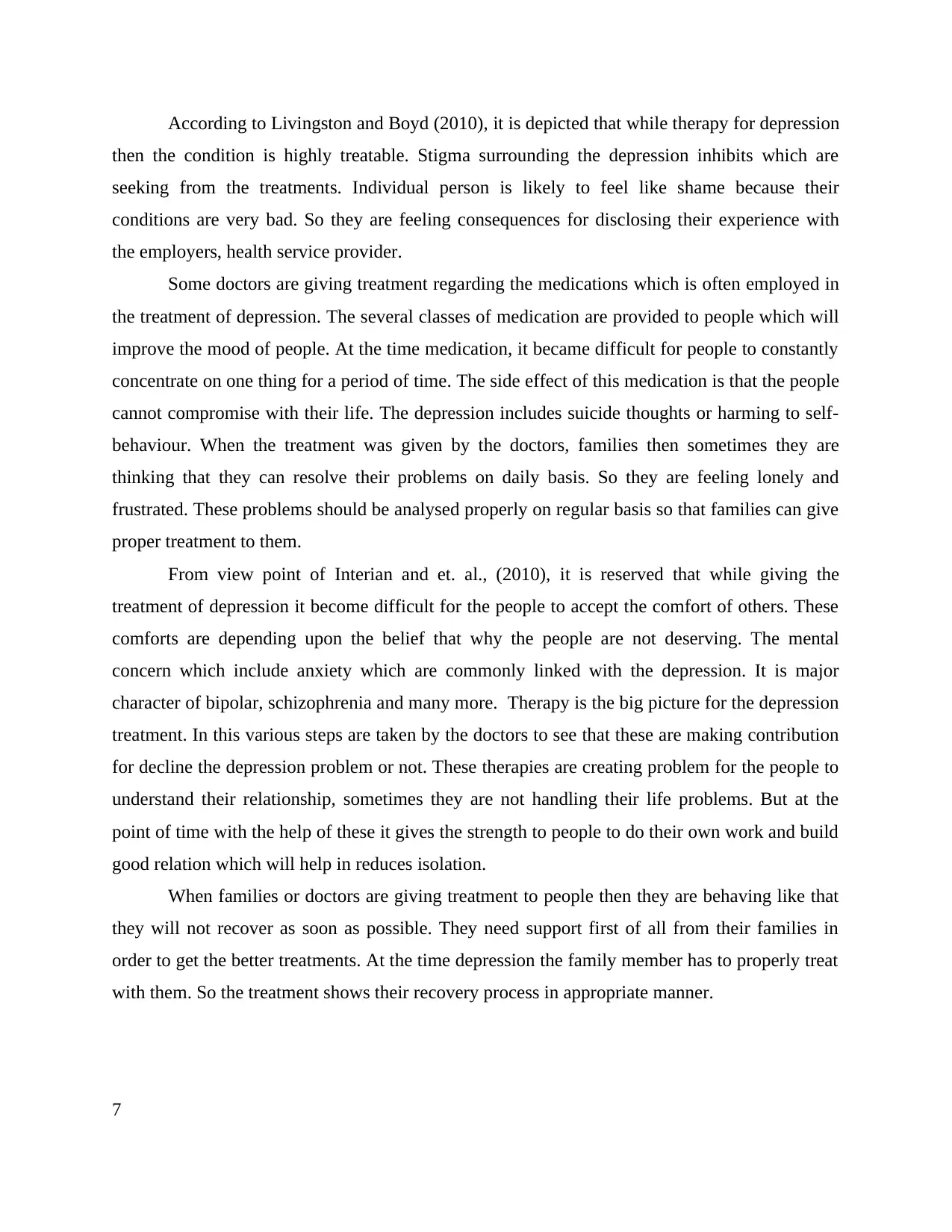
According to Livingston and Boyd (2010), it is depicted that while therapy for depression
then the condition is highly treatable. Stigma surrounding the depression inhibits which are
seeking from the treatments. Individual person is likely to feel like shame because their
conditions are very bad. So they are feeling consequences for disclosing their experience with
the employers, health service provider.
Some doctors are giving treatment regarding the medications which is often employed in
the treatment of depression. The several classes of medication are provided to people which will
improve the mood of people. At the time medication, it became difficult for people to constantly
concentrate on one thing for a period of time. The side effect of this medication is that the people
cannot compromise with their life. The depression includes suicide thoughts or harming to self-
behaviour. When the treatment was given by the doctors, families then sometimes they are
thinking that they can resolve their problems on daily basis. So they are feeling lonely and
frustrated. These problems should be analysed properly on regular basis so that families can give
proper treatment to them.
From view point of Interian and et. al., (2010), it is reserved that while giving the
treatment of depression it become difficult for the people to accept the comfort of others. These
comforts are depending upon the belief that why the people are not deserving. The mental
concern which include anxiety which are commonly linked with the depression. It is major
character of bipolar, schizophrenia and many more. Therapy is the big picture for the depression
treatment. In this various steps are taken by the doctors to see that these are making contribution
for decline the depression problem or not. These therapies are creating problem for the people to
understand their relationship, sometimes they are not handling their life problems. But at the
point of time with the help of these it gives the strength to people to do their own work and build
good relation which will help in reduces isolation.
When families or doctors are giving treatment to people then they are behaving like that
they will not recover as soon as possible. They need support first of all from their families in
order to get the better treatments. At the time depression the family member has to properly treat
with them. So the treatment shows their recovery process in appropriate manner.
7
then the condition is highly treatable. Stigma surrounding the depression inhibits which are
seeking from the treatments. Individual person is likely to feel like shame because their
conditions are very bad. So they are feeling consequences for disclosing their experience with
the employers, health service provider.
Some doctors are giving treatment regarding the medications which is often employed in
the treatment of depression. The several classes of medication are provided to people which will
improve the mood of people. At the time medication, it became difficult for people to constantly
concentrate on one thing for a period of time. The side effect of this medication is that the people
cannot compromise with their life. The depression includes suicide thoughts or harming to self-
behaviour. When the treatment was given by the doctors, families then sometimes they are
thinking that they can resolve their problems on daily basis. So they are feeling lonely and
frustrated. These problems should be analysed properly on regular basis so that families can give
proper treatment to them.
From view point of Interian and et. al., (2010), it is reserved that while giving the
treatment of depression it become difficult for the people to accept the comfort of others. These
comforts are depending upon the belief that why the people are not deserving. The mental
concern which include anxiety which are commonly linked with the depression. It is major
character of bipolar, schizophrenia and many more. Therapy is the big picture for the depression
treatment. In this various steps are taken by the doctors to see that these are making contribution
for decline the depression problem or not. These therapies are creating problem for the people to
understand their relationship, sometimes they are not handling their life problems. But at the
point of time with the help of these it gives the strength to people to do their own work and build
good relation which will help in reduces isolation.
When families or doctors are giving treatment to people then they are behaving like that
they will not recover as soon as possible. They need support first of all from their families in
order to get the better treatments. At the time depression the family member has to properly treat
with them. So the treatment shows their recovery process in appropriate manner.
7
Paraphrase This Document
Need a fresh take? Get an instant paraphrase of this document with our AI Paraphraser
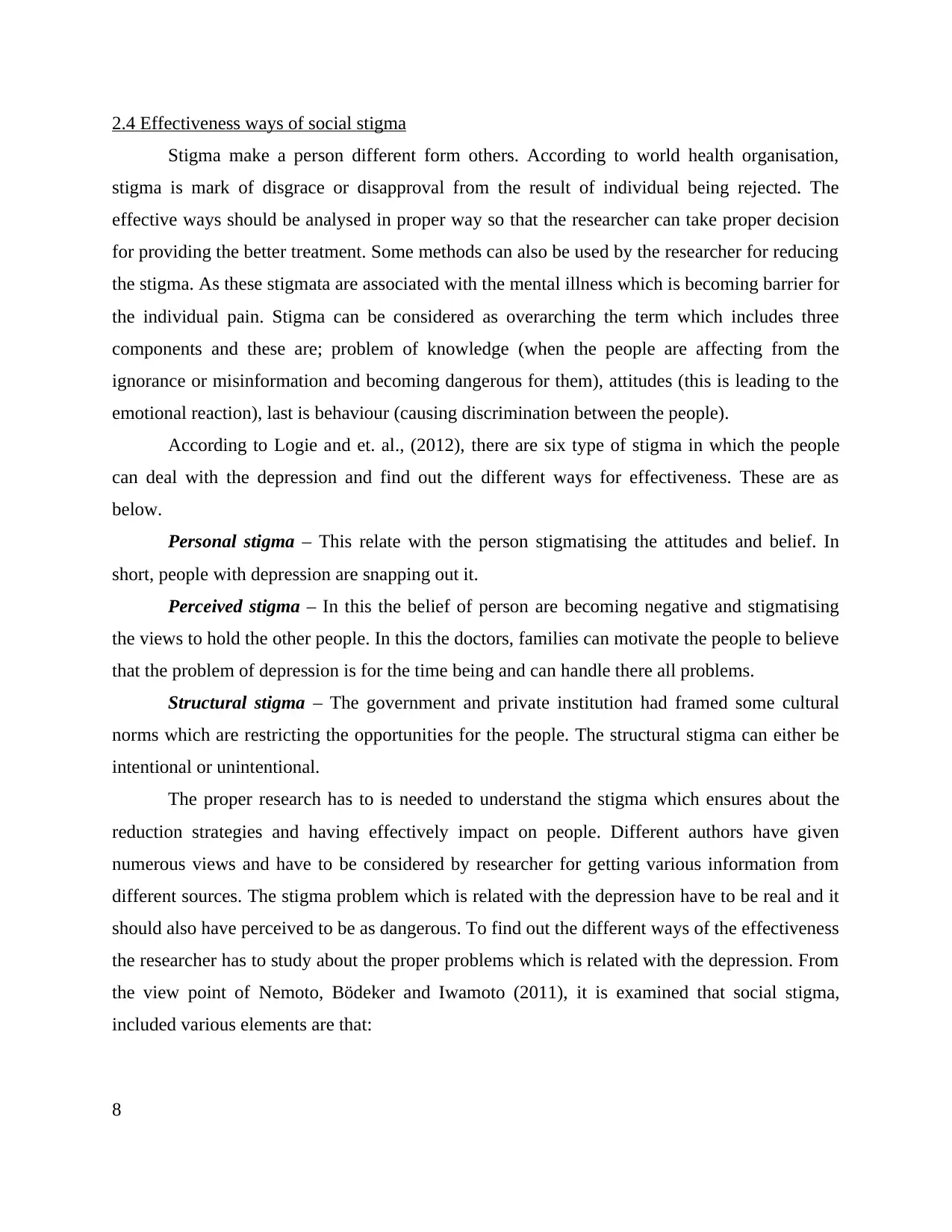
2.4 Effectiveness ways of social stigma
Stigma make a person different form others. According to world health organisation,
stigma is mark of disgrace or disapproval from the result of individual being rejected. The
effective ways should be analysed in proper way so that the researcher can take proper decision
for providing the better treatment. Some methods can also be used by the researcher for reducing
the stigma. As these stigmata are associated with the mental illness which is becoming barrier for
the individual pain. Stigma can be considered as overarching the term which includes three
components and these are; problem of knowledge (when the people are affecting from the
ignorance or misinformation and becoming dangerous for them), attitudes (this is leading to the
emotional reaction), last is behaviour (causing discrimination between the people).
According to Logie and et. al., (2012), there are six type of stigma in which the people
can deal with the depression and find out the different ways for effectiveness. These are as
below.
Personal stigma – This relate with the person stigmatising the attitudes and belief. In
short, people with depression are snapping out it.
Perceived stigma – In this the belief of person are becoming negative and stigmatising
the views to hold the other people. In this the doctors, families can motivate the people to believe
that the problem of depression is for the time being and can handle there all problems.
Structural stigma – The government and private institution had framed some cultural
norms which are restricting the opportunities for the people. The structural stigma can either be
intentional or unintentional.
The proper research has to is needed to understand the stigma which ensures about the
reduction strategies and having effectively impact on people. Different authors have given
numerous views and have to be considered by researcher for getting various information from
different sources. The stigma problem which is related with the depression have to be real and it
should also have perceived to be as dangerous. To find out the different ways of the effectiveness
the researcher has to study about the proper problems which is related with the depression. From
the view point of Nemoto, Bödeker and Iwamoto (2011), it is examined that social stigma,
included various elements are that:
8
Stigma make a person different form others. According to world health organisation,
stigma is mark of disgrace or disapproval from the result of individual being rejected. The
effective ways should be analysed in proper way so that the researcher can take proper decision
for providing the better treatment. Some methods can also be used by the researcher for reducing
the stigma. As these stigmata are associated with the mental illness which is becoming barrier for
the individual pain. Stigma can be considered as overarching the term which includes three
components and these are; problem of knowledge (when the people are affecting from the
ignorance or misinformation and becoming dangerous for them), attitudes (this is leading to the
emotional reaction), last is behaviour (causing discrimination between the people).
According to Logie and et. al., (2012), there are six type of stigma in which the people
can deal with the depression and find out the different ways for effectiveness. These are as
below.
Personal stigma – This relate with the person stigmatising the attitudes and belief. In
short, people with depression are snapping out it.
Perceived stigma – In this the belief of person are becoming negative and stigmatising
the views to hold the other people. In this the doctors, families can motivate the people to believe
that the problem of depression is for the time being and can handle there all problems.
Structural stigma – The government and private institution had framed some cultural
norms which are restricting the opportunities for the people. The structural stigma can either be
intentional or unintentional.
The proper research has to is needed to understand the stigma which ensures about the
reduction strategies and having effectively impact on people. Different authors have given
numerous views and have to be considered by researcher for getting various information from
different sources. The stigma problem which is related with the depression have to be real and it
should also have perceived to be as dangerous. To find out the different ways of the effectiveness
the researcher has to study about the proper problems which is related with the depression. From
the view point of Nemoto, Bödeker and Iwamoto (2011), it is examined that social stigma,
included various elements are that:
8
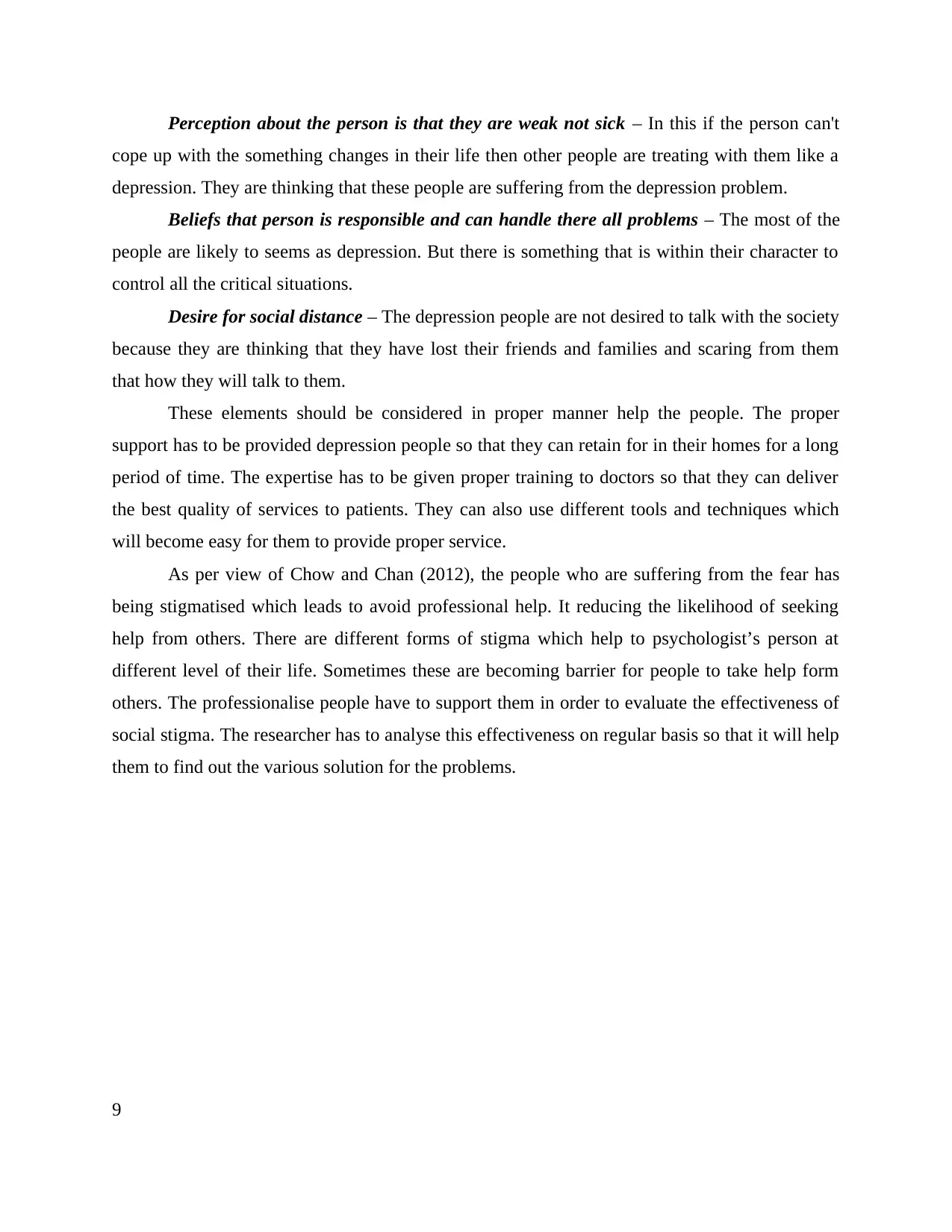
Perception about the person is that they are weak not sick – In this if the person can't
cope up with the something changes in their life then other people are treating with them like a
depression. They are thinking that these people are suffering from the depression problem.
Beliefs that person is responsible and can handle there all problems – The most of the
people are likely to seems as depression. But there is something that is within their character to
control all the critical situations.
Desire for social distance – The depression people are not desired to talk with the society
because they are thinking that they have lost their friends and families and scaring from them
that how they will talk to them.
These elements should be considered in proper manner help the people. The proper
support has to be provided depression people so that they can retain for in their homes for a long
period of time. The expertise has to be given proper training to doctors so that they can deliver
the best quality of services to patients. They can also use different tools and techniques which
will become easy for them to provide proper service.
As per view of Chow and Chan (2012), the people who are suffering from the fear has
being stigmatised which leads to avoid professional help. It reducing the likelihood of seeking
help from others. There are different forms of stigma which help to psychologist’s person at
different level of their life. Sometimes these are becoming barrier for people to take help form
others. The professionalise people have to support them in order to evaluate the effectiveness of
social stigma. The researcher has to analyse this effectiveness on regular basis so that it will help
them to find out the various solution for the problems.
9
cope up with the something changes in their life then other people are treating with them like a
depression. They are thinking that these people are suffering from the depression problem.
Beliefs that person is responsible and can handle there all problems – The most of the
people are likely to seems as depression. But there is something that is within their character to
control all the critical situations.
Desire for social distance – The depression people are not desired to talk with the society
because they are thinking that they have lost their friends and families and scaring from them
that how they will talk to them.
These elements should be considered in proper manner help the people. The proper
support has to be provided depression people so that they can retain for in their homes for a long
period of time. The expertise has to be given proper training to doctors so that they can deliver
the best quality of services to patients. They can also use different tools and techniques which
will become easy for them to provide proper service.
As per view of Chow and Chan (2012), the people who are suffering from the fear has
being stigmatised which leads to avoid professional help. It reducing the likelihood of seeking
help from others. There are different forms of stigma which help to psychologist’s person at
different level of their life. Sometimes these are becoming barrier for people to take help form
others. The professionalise people have to support them in order to evaluate the effectiveness of
social stigma. The researcher has to analyse this effectiveness on regular basis so that it will help
them to find out the various solution for the problems.
9
⊘ This is a preview!⊘
Do you want full access?
Subscribe today to unlock all pages.

Trusted by 1+ million students worldwide
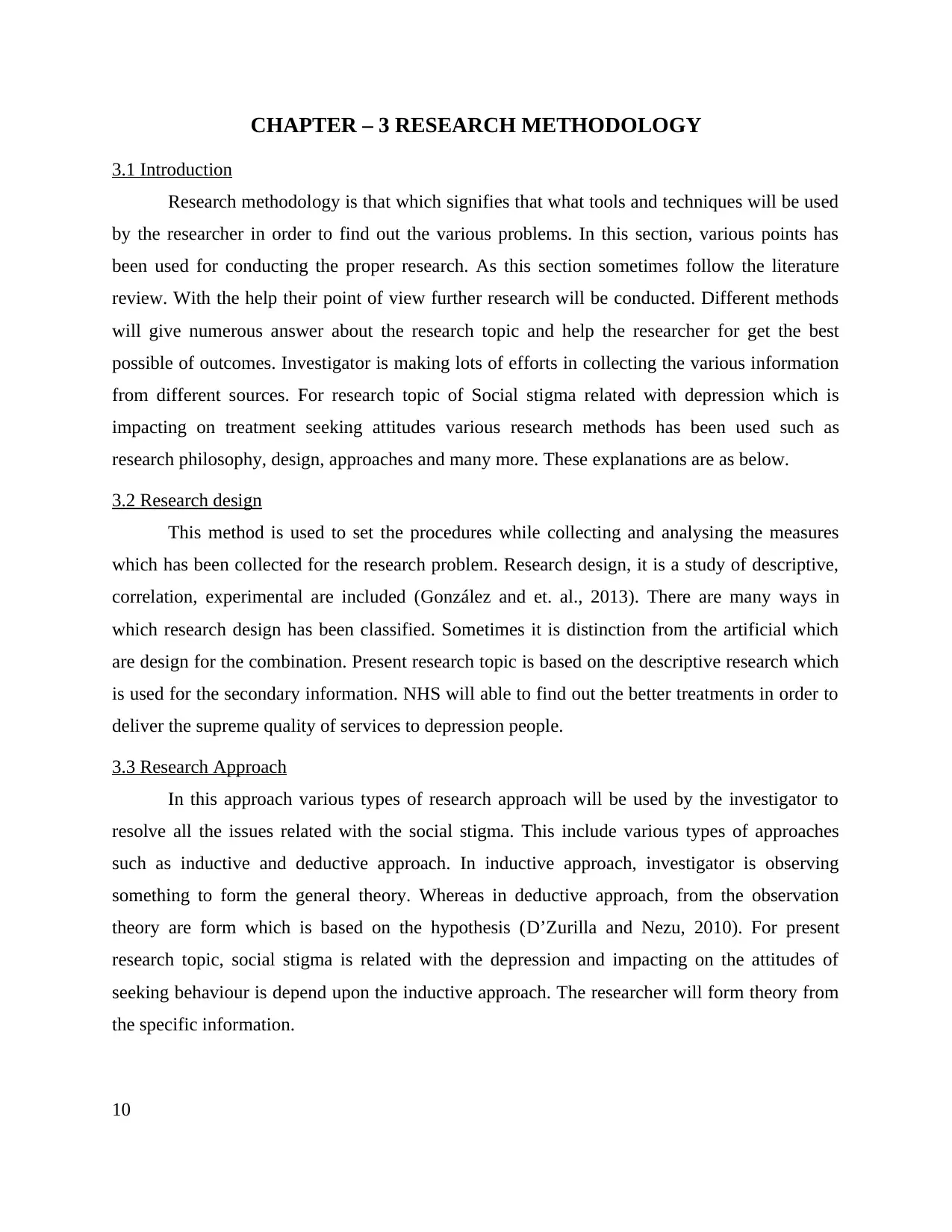
CHAPTER – 3 RESEARCH METHODOLOGY
3.1 Introduction
Research methodology is that which signifies that what tools and techniques will be used
by the researcher in order to find out the various problems. In this section, various points has
been used for conducting the proper research. As this section sometimes follow the literature
review. With the help their point of view further research will be conducted. Different methods
will give numerous answer about the research topic and help the researcher for get the best
possible of outcomes. Investigator is making lots of efforts in collecting the various information
from different sources. For research topic of Social stigma related with depression which is
impacting on treatment seeking attitudes various research methods has been used such as
research philosophy, design, approaches and many more. These explanations are as below.
3.2 Research design
This method is used to set the procedures while collecting and analysing the measures
which has been collected for the research problem. Research design, it is a study of descriptive,
correlation, experimental are included (González and et. al., 2013). There are many ways in
which research design has been classified. Sometimes it is distinction from the artificial which
are design for the combination. Present research topic is based on the descriptive research which
is used for the secondary information. NHS will able to find out the better treatments in order to
deliver the supreme quality of services to depression people.
3.3 Research Approach
In this approach various types of research approach will be used by the investigator to
resolve all the issues related with the social stigma. This include various types of approaches
such as inductive and deductive approach. In inductive approach, investigator is observing
something to form the general theory. Whereas in deductive approach, from the observation
theory are form which is based on the hypothesis (D’Zurilla and Nezu, 2010). For present
research topic, social stigma is related with the depression and impacting on the attitudes of
seeking behaviour is depend upon the inductive approach. The researcher will form theory from
the specific information.
10
3.1 Introduction
Research methodology is that which signifies that what tools and techniques will be used
by the researcher in order to find out the various problems. In this section, various points has
been used for conducting the proper research. As this section sometimes follow the literature
review. With the help their point of view further research will be conducted. Different methods
will give numerous answer about the research topic and help the researcher for get the best
possible of outcomes. Investigator is making lots of efforts in collecting the various information
from different sources. For research topic of Social stigma related with depression which is
impacting on treatment seeking attitudes various research methods has been used such as
research philosophy, design, approaches and many more. These explanations are as below.
3.2 Research design
This method is used to set the procedures while collecting and analysing the measures
which has been collected for the research problem. Research design, it is a study of descriptive,
correlation, experimental are included (González and et. al., 2013). There are many ways in
which research design has been classified. Sometimes it is distinction from the artificial which
are design for the combination. Present research topic is based on the descriptive research which
is used for the secondary information. NHS will able to find out the better treatments in order to
deliver the supreme quality of services to depression people.
3.3 Research Approach
In this approach various types of research approach will be used by the investigator to
resolve all the issues related with the social stigma. This include various types of approaches
such as inductive and deductive approach. In inductive approach, investigator is observing
something to form the general theory. Whereas in deductive approach, from the observation
theory are form which is based on the hypothesis (D’Zurilla and Nezu, 2010). For present
research topic, social stigma is related with the depression and impacting on the attitudes of
seeking behaviour is depend upon the inductive approach. The researcher will form theory from
the specific information.
10
Paraphrase This Document
Need a fresh take? Get an instant paraphrase of this document with our AI Paraphraser
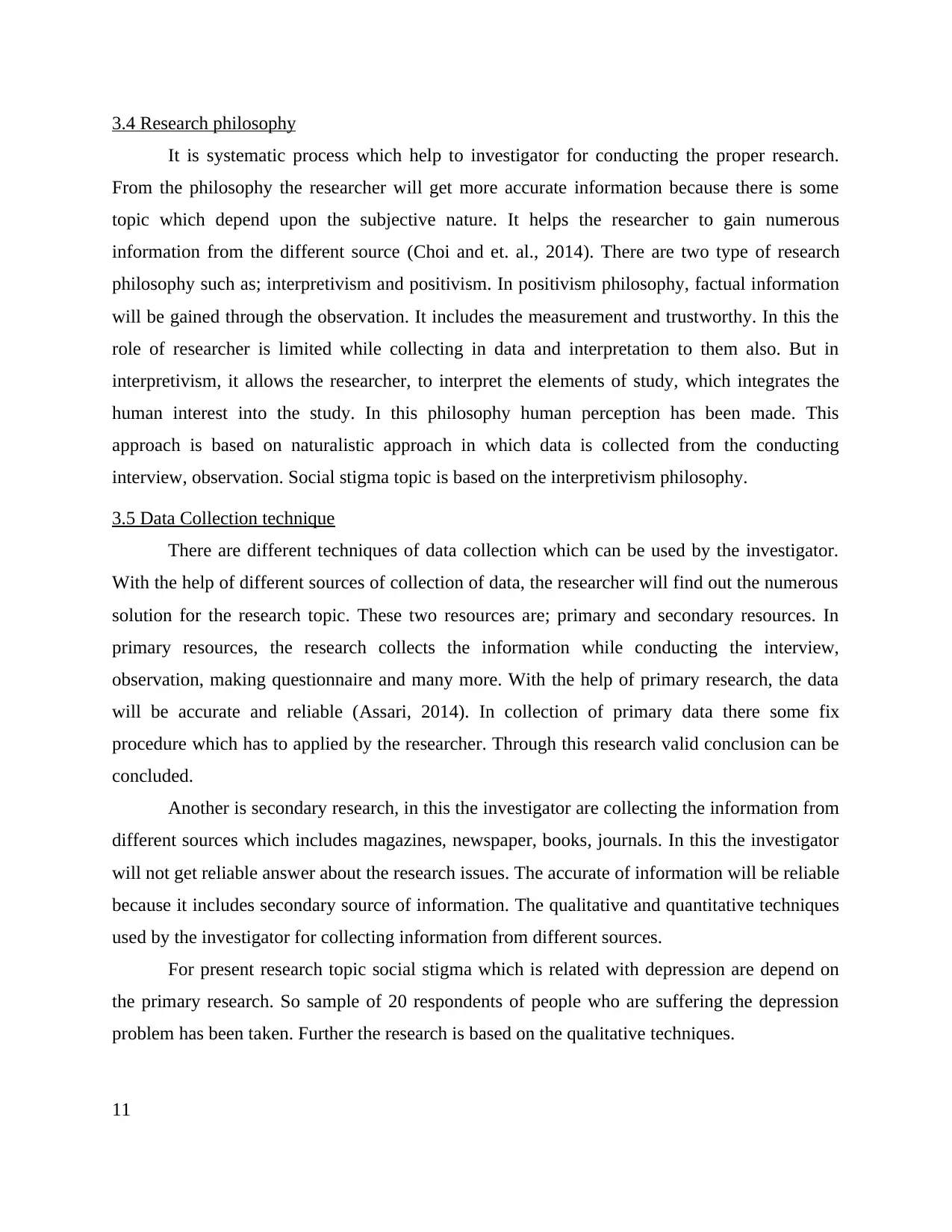
3.4 Research philosophy
It is systematic process which help to investigator for conducting the proper research.
From the philosophy the researcher will get more accurate information because there is some
topic which depend upon the subjective nature. It helps the researcher to gain numerous
information from the different source (Choi and et. al., 2014). There are two type of research
philosophy such as; interpretivism and positivism. In positivism philosophy, factual information
will be gained through the observation. It includes the measurement and trustworthy. In this the
role of researcher is limited while collecting in data and interpretation to them also. But in
interpretivism, it allows the researcher, to interpret the elements of study, which integrates the
human interest into the study. In this philosophy human perception has been made. This
approach is based on naturalistic approach in which data is collected from the conducting
interview, observation. Social stigma topic is based on the interpretivism philosophy.
3.5 Data Collection technique
There are different techniques of data collection which can be used by the investigator.
With the help of different sources of collection of data, the researcher will find out the numerous
solution for the research topic. These two resources are; primary and secondary resources. In
primary resources, the research collects the information while conducting the interview,
observation, making questionnaire and many more. With the help of primary research, the data
will be accurate and reliable (Assari, 2014). In collection of primary data there some fix
procedure which has to applied by the researcher. Through this research valid conclusion can be
concluded.
Another is secondary research, in this the investigator are collecting the information from
different sources which includes magazines, newspaper, books, journals. In this the investigator
will not get reliable answer about the research issues. The accurate of information will be reliable
because it includes secondary source of information. The qualitative and quantitative techniques
used by the investigator for collecting information from different sources.
For present research topic social stigma which is related with depression are depend on
the primary research. So sample of 20 respondents of people who are suffering the depression
problem has been taken. Further the research is based on the qualitative techniques.
11
It is systematic process which help to investigator for conducting the proper research.
From the philosophy the researcher will get more accurate information because there is some
topic which depend upon the subjective nature. It helps the researcher to gain numerous
information from the different source (Choi and et. al., 2014). There are two type of research
philosophy such as; interpretivism and positivism. In positivism philosophy, factual information
will be gained through the observation. It includes the measurement and trustworthy. In this the
role of researcher is limited while collecting in data and interpretation to them also. But in
interpretivism, it allows the researcher, to interpret the elements of study, which integrates the
human interest into the study. In this philosophy human perception has been made. This
approach is based on naturalistic approach in which data is collected from the conducting
interview, observation. Social stigma topic is based on the interpretivism philosophy.
3.5 Data Collection technique
There are different techniques of data collection which can be used by the investigator.
With the help of different sources of collection of data, the researcher will find out the numerous
solution for the research topic. These two resources are; primary and secondary resources. In
primary resources, the research collects the information while conducting the interview,
observation, making questionnaire and many more. With the help of primary research, the data
will be accurate and reliable (Assari, 2014). In collection of primary data there some fix
procedure which has to applied by the researcher. Through this research valid conclusion can be
concluded.
Another is secondary research, in this the investigator are collecting the information from
different sources which includes magazines, newspaper, books, journals. In this the investigator
will not get reliable answer about the research issues. The accurate of information will be reliable
because it includes secondary source of information. The qualitative and quantitative techniques
used by the investigator for collecting information from different sources.
For present research topic social stigma which is related with depression are depend on
the primary research. So sample of 20 respondents of people who are suffering the depression
problem has been taken. Further the research is based on the qualitative techniques.
11
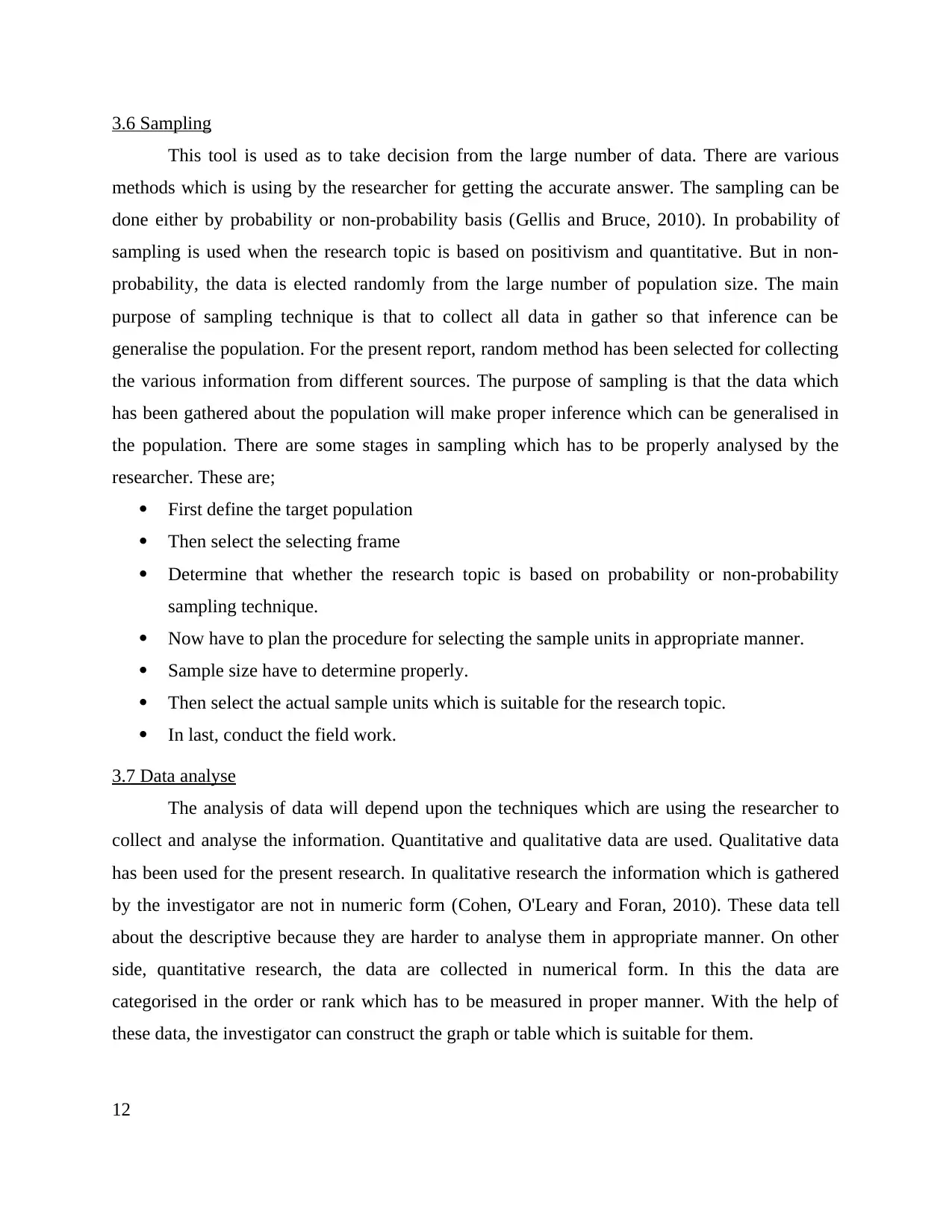
3.6 Sampling
This tool is used as to take decision from the large number of data. There are various
methods which is using by the researcher for getting the accurate answer. The sampling can be
done either by probability or non-probability basis (Gellis and Bruce, 2010). In probability of
sampling is used when the research topic is based on positivism and quantitative. But in non-
probability, the data is elected randomly from the large number of population size. The main
purpose of sampling technique is that to collect all data in gather so that inference can be
generalise the population. For the present report, random method has been selected for collecting
the various information from different sources. The purpose of sampling is that the data which
has been gathered about the population will make proper inference which can be generalised in
the population. There are some stages in sampling which has to be properly analysed by the
researcher. These are;
First define the target population
Then select the selecting frame
Determine that whether the research topic is based on probability or non-probability
sampling technique.
Now have to plan the procedure for selecting the sample units in appropriate manner.
Sample size have to determine properly.
Then select the actual sample units which is suitable for the research topic.
In last, conduct the field work.
3.7 Data analyse
The analysis of data will depend upon the techniques which are using the researcher to
collect and analyse the information. Quantitative and qualitative data are used. Qualitative data
has been used for the present research. In qualitative research the information which is gathered
by the investigator are not in numeric form (Cohen, O'Leary and Foran, 2010). These data tell
about the descriptive because they are harder to analyse them in appropriate manner. On other
side, quantitative research, the data are collected in numerical form. In this the data are
categorised in the order or rank which has to be measured in proper manner. With the help of
these data, the investigator can construct the graph or table which is suitable for them.
12
This tool is used as to take decision from the large number of data. There are various
methods which is using by the researcher for getting the accurate answer. The sampling can be
done either by probability or non-probability basis (Gellis and Bruce, 2010). In probability of
sampling is used when the research topic is based on positivism and quantitative. But in non-
probability, the data is elected randomly from the large number of population size. The main
purpose of sampling technique is that to collect all data in gather so that inference can be
generalise the population. For the present report, random method has been selected for collecting
the various information from different sources. The purpose of sampling is that the data which
has been gathered about the population will make proper inference which can be generalised in
the population. There are some stages in sampling which has to be properly analysed by the
researcher. These are;
First define the target population
Then select the selecting frame
Determine that whether the research topic is based on probability or non-probability
sampling technique.
Now have to plan the procedure for selecting the sample units in appropriate manner.
Sample size have to determine properly.
Then select the actual sample units which is suitable for the research topic.
In last, conduct the field work.
3.7 Data analyse
The analysis of data will depend upon the techniques which are using the researcher to
collect and analyse the information. Quantitative and qualitative data are used. Qualitative data
has been used for the present research. In qualitative research the information which is gathered
by the investigator are not in numeric form (Cohen, O'Leary and Foran, 2010). These data tell
about the descriptive because they are harder to analyse them in appropriate manner. On other
side, quantitative research, the data are collected in numerical form. In this the data are
categorised in the order or rank which has to be measured in proper manner. With the help of
these data, the investigator can construct the graph or table which is suitable for them.
12
⊘ This is a preview!⊘
Do you want full access?
Subscribe today to unlock all pages.

Trusted by 1+ million students worldwide
1 out of 27
Related Documents
Your All-in-One AI-Powered Toolkit for Academic Success.
+13062052269
info@desklib.com
Available 24*7 on WhatsApp / Email
![[object Object]](/_next/static/media/star-bottom.7253800d.svg)
Unlock your academic potential
Copyright © 2020–2025 A2Z Services. All Rights Reserved. Developed and managed by ZUCOL.





